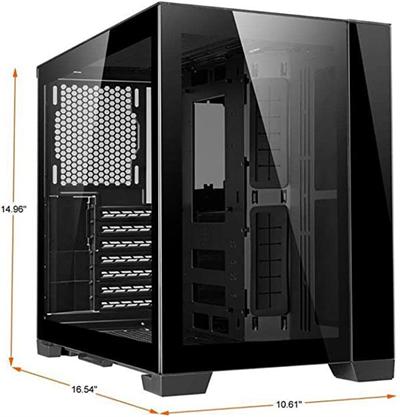Lian-Li Case O11D Mini -X Mid Tower Black 2×2.5 2×3.5 ATX
Product details
- SPCC / Aluminum / Tempered Glass ATX Mini Tower
- 2 x USB 3.0 / 1 x USB 3.1 Type-C / HD Audio Front Ports
- 2 x 3.5″ HDD (or SSD) Internal 3.5″ Drive Bays
Test of thermal performance: excellent as anticipated
One 12cm fan can be installed at the back, three 12cm or two 14cm fans can be installed at the bottom, two 14cm or 12cm fans can be installed vertically next to the motherboard, and three 12cm or two 14cm fans can be installed at the top of the case. The bottom air intake, the back panel (if a vertical fan is placed), and the top air exit make up the total air duct planning. If the Lianli O11D MINI is loaded down with fans, the heat dissipation scale will be quite erratic in terms of setup. This compact box, which theoretically provides good heat dissipation conditions, can accommodate a total of nine fans.
Our case cooling performance test uses a unique methodology that can improve consistency and make it easier to compare cooling performance across different cases. The chassis can be thought of as a radiator, and the heating module and radiator as a sizable heating body. Depending on how well the chassis’ radiator performs, this big heating body’s power consumption and temperature will change. Testing can be used to determine the temperature difference and power consumption inside and outside of the chassis, which can then be used to calculate its thermal resistance. A super energy index is created by converting the heat dissipation performance index:
Exp = 3.3*Pd/(10+Tc – Ta)
The larger the ambient temperature, the larger the Exp, the better the heat dissipation performance of the chassis. Pd denotes the average power consumption of the heating module after stabilization. Tc denotes the surface temperature of the heating module. Here is the average temperature in the chassis. Our test point is 5 cm in front of the CPU radiator fan. The radiator fan on our case cooling test model (Xianma Bingxue 130), which has a fixed air-cooled radiator, runs at full speed during the test. One rear air outlet and a fully loaded front air intake fan are how the chassis fan is set up. The chassis fan’s speed is managed at 1000RPM. The ProArtist M12 fan is used consistently and at a speed of 1000RPM if the chassis lacks a regular fan.

